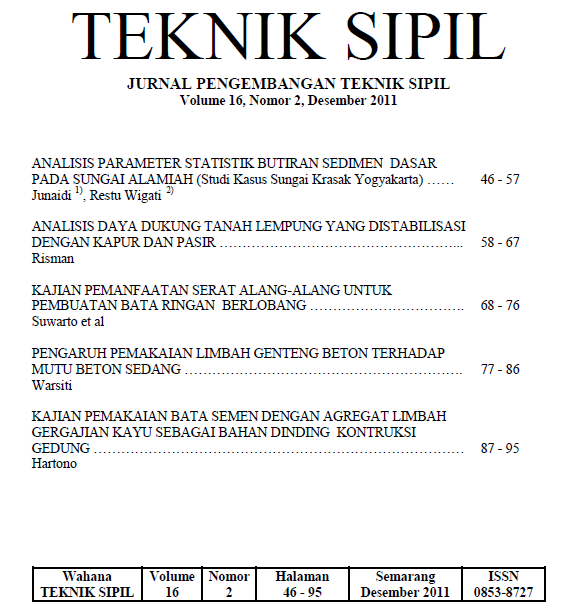Analisis Daya Dukung Tanah Lempung Yang Distabilisasi Dengan Kapur Dan Pasir
DOI:
https://doi.org/10.32497/wahanats.v16i2.107Keywords:
stabilisasi, kompaksi, daya dukung tanah, CBRAbstract
Soil with a high shrinkage value flowers, water affects the physical and mechanical behavior of soil (Das, 1994). Expansive clays generally have less favorable properties such as dry density (ï§ d) low maximum, capacity / California Bearing Ratio (CBR) is low, low shear strength, and flowers shrinkage (Swelling) high. Nature is what causes the often damaged pavement repair is often done even if the pavement structure. Condition of roads in the Spring Mulyo also experienced the same thing that is fast though damage is often done to improve the road surface layer. To overcome these problems one way or the method used is to improve the quality of the original soil (stabilization). The study was conducted to find out more about the influence of lime and sand stabilization material to the amount of soil bearing capacity and CBR. Laboratory testing includes testing the soil compaction and CBR. The percentage increase varied from 5% sand, 10%, and 15%. While the addition of lime percentage varies from 5%, 10% and 15%. In this study indicates that the addition of lime and sand to clay soil has a tendency to increase the density of the soil, soil CBR value well in conditions without a bath or a bath. The optimum condition occurs in a mixture of clay with 10% limestone and 15% sand with a CBR value 9.08% with the soaked and the CBR value of 20.06% with unsoaked
Downloads
Published
Issue
Section
License
Authors who publish with this journal agree to the following terms:Authors retain copyright and grant the journal right of first publication with the work simultaneously licensed under a Creative Commons Attribution License that allows others to share the work with an acknowledgement of the work's authorship and initial publication in this journal.
Authors are able to enter into separate, additional contractual arrangements for the non-exclusive distribution of the journal's published version of the work (e.g., post it to an institutional repository or publish it in a book), with an acknowledgement of its initial publication in this journal.
Authors are permitted and encouraged to post their work online (e.g., in institutional repositories or on their website) prior to and during the submission process, as it can lead to productive exchanges, as well as earlier and greater citation of published work (See The Effect of Open Access).






